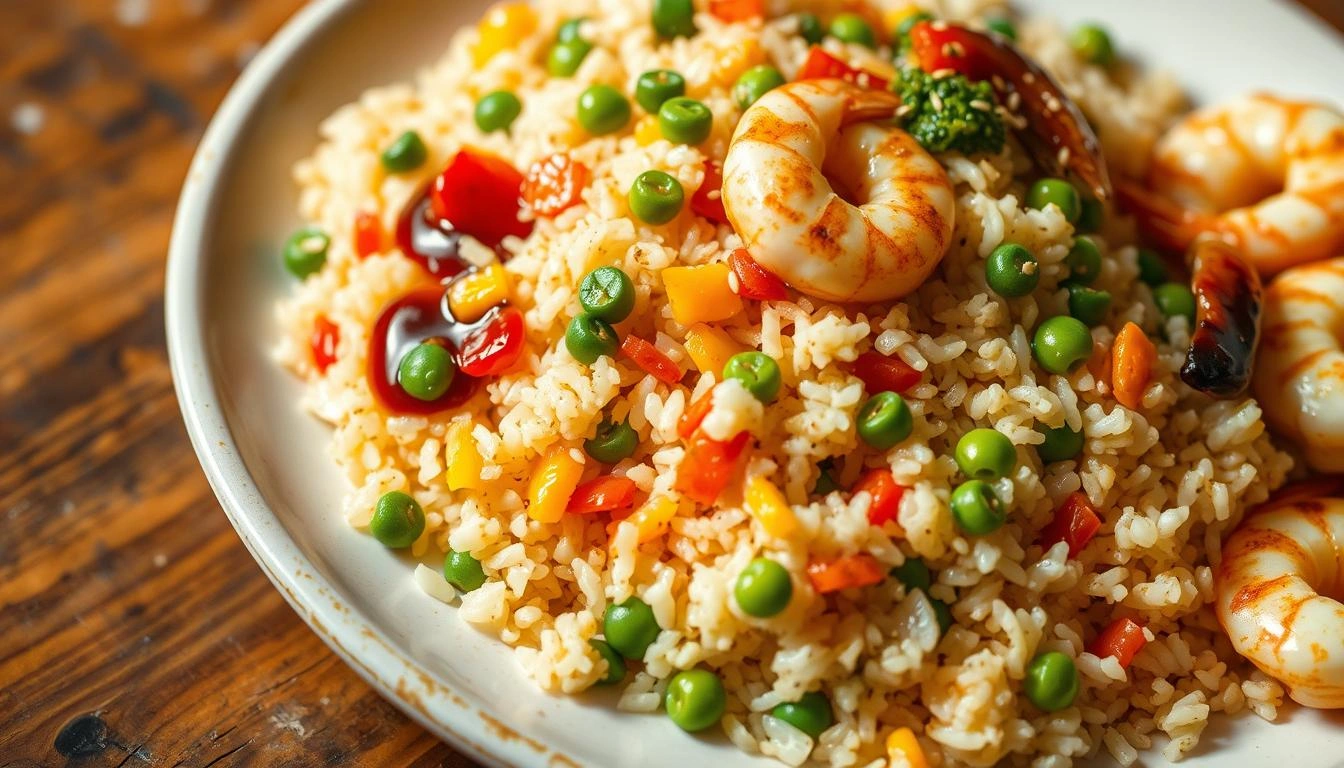As a busy mom, I often crave the flavors of hibachi-style fried rice from my favorite Japanese restaurant. The sizzling sounds and perfectly cooked rice are amazing. They make me feel like I’m at a serene outdoor teppanyaki table, watching a chef’s skillful performance.
But what if you could make this experience at home? With just a few simple steps, you can.
In this article, I’ll show you how to make a delicious hibachi fried rice recipe that will wow your family and friends. It doesn’t matter if you’re a seasoned cook or just starting out. You’ll find that this Japanese rice dish is easy to make, thanks to the teppanyaki-style cooking techniques I’ll share.
What is Hibachi Fried Rice?
Hibachi fried rice is a tasty dish from Japan’s rich culinary traditions. It’s a favorite in Asian cuisine for its bold flavors and sizzling shows. It brings diners to the lively heart of a hibachi grill recipes.
The Origins of Hibachi Cooking
Hibachi cooking started with Japanese teppanyaki. Chefs use a flat iron griddle to cook fresh ingredients right at your table. This style of cooking has won hearts worldwide, leading to restaurant-style fried rice that’s just as exciting.
Key Ingredients in Hibachi Fried Rice
The perfect hibachi grill recipes need the right ingredients. Hibachi fried rice includes:
- Short-grain or medium-grain rice, cooked just right
- Fresh veggies like carrots, onions, and bean sprouts
- Proteins like chicken, shrimp, or steak, marinated for flavor
- Seasonings like soy sauce, sesame oil, and garlic for a rich taste
The special cooking methods in hibachi enhance these ingredients. This makes the restaurant-style fried rice a treat for your taste buds.
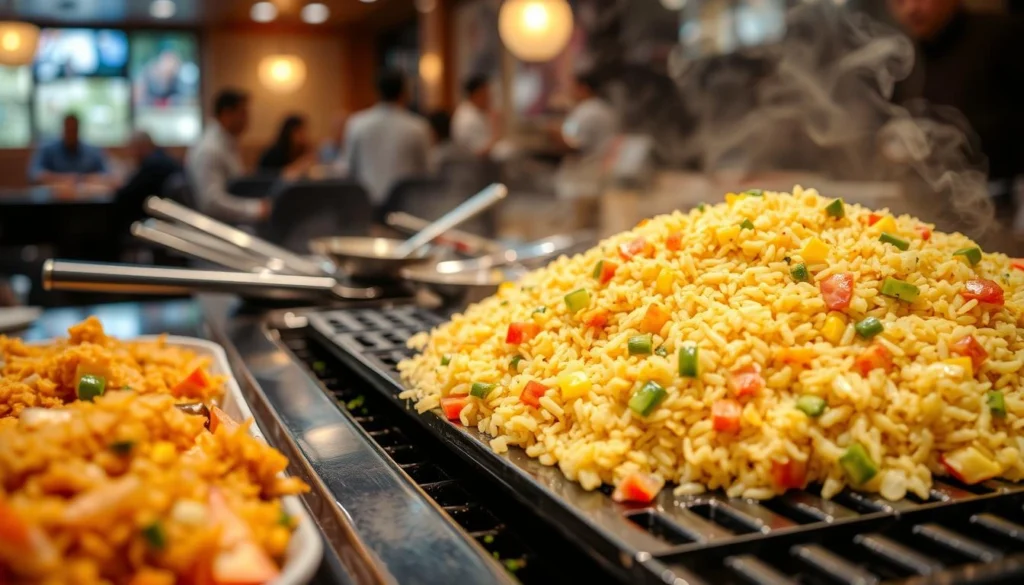
Essential Tools for Making Hibachi Fried Rice
To bring the teppanyaki style cooking into your home, you need some key tools. For hibachi fried rice, the right cookware and gadgets are crucial. Let’s look at the must-haves for top-notch results.
Recommended Cookware
A flat-top griddle or a large, heavy-duty skillet is essential. They help in searing and caramelizing ingredients. Choose a pan with a flat, smooth surface for large volumes of rice and ingredients. Cast-iron or stainless steel pans are great options.
Useful Kitchen Gadgets
Along with the right cookware, some gadgets make hibachi fried rice prep easier. Metal spatulas with long handles are great for tossing ingredients. Squeeze bottles help with drizzling sauces and seasonings. Sharp knives are also important for chopping veggies and proteins.
With the right tools, you can make delicious hibachi fried rice at home. It will be just as good as your favorite restaurant’s.
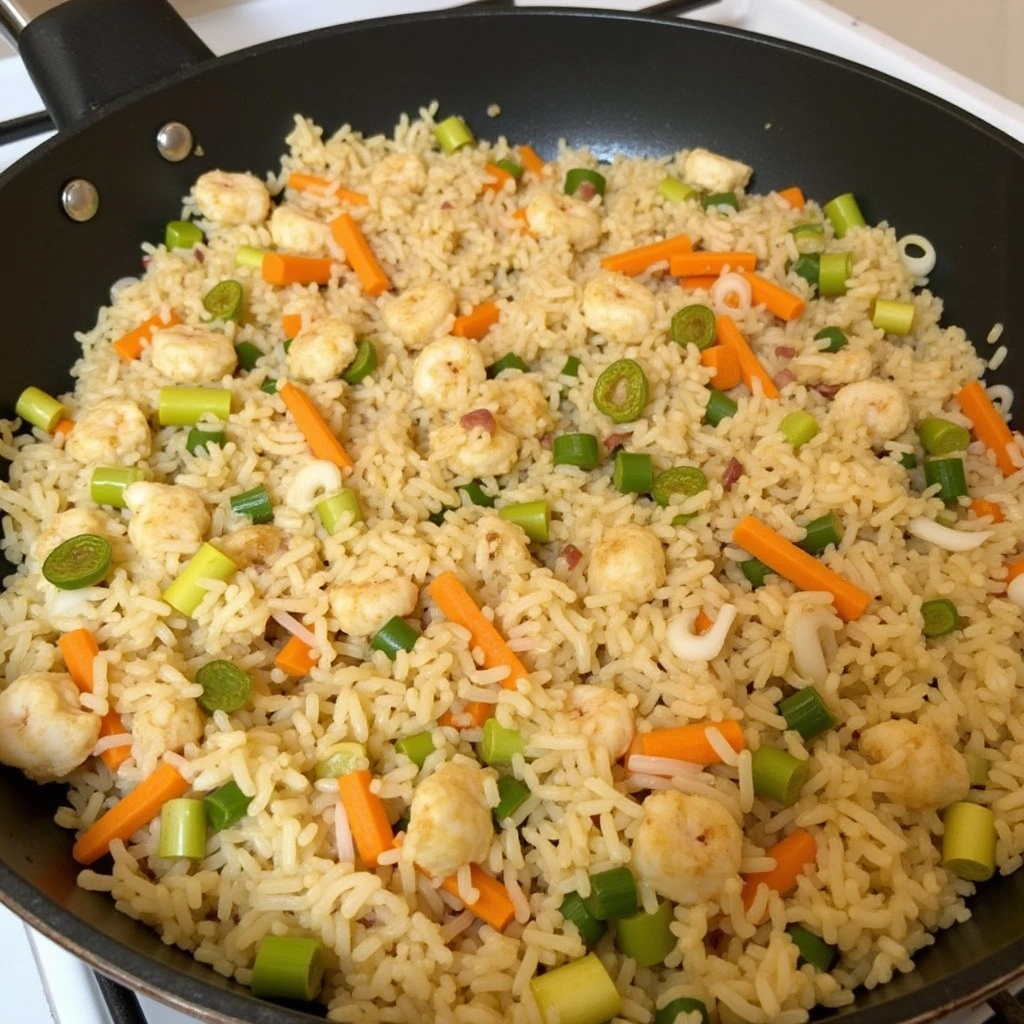
Key Ingredients for the Perfect Hibachi Fried Rice
Making tasty hibachi fried rice starts with picking the right ingredients. You need the right rice, vegetables, and proteins. Each part is crucial for a dish that tastes like it came from a restaurant. Let’s look at the key ingredients to make your homemade hibachi fried rice amazing.
Types of Rice You Can Use
Traditional hibachi fried rice uses short-grain Japanese rice. But, you can try different types of rice for your taste. Here are some good options:
- Jasmine rice: This long-grain rice has a delicate flavor that goes well with other ingredients.
- Brown rice: It’s a healthier choice with a nutty taste that adds nutrition to your dish.
- Basmati rice: Its long grains give a unique aroma and texture to your fried rice.
Vegetables to Include
Asian cuisine often uses a variety of fresh vegetables in fried rice. Here are some tasty choices:
- Carrots: Diced or julienned, they add a sweet crunch.
- Onions: Yellow, white, or red onions bring a savory flavor.
- Peas: Frozen peas add color and sweetness.
- Bean sprouts: They’re crunchy and full of nutrients.
- Broccoli: Florets or chopped stems are healthy and flavorful.
Protein Options for a Hearty Meal
To make your fried rice a filling meal, add protein. Here are some good choices:
| Protein | Benefits |
|---|---|
| Chicken | Lean and versatile, chicken is a great protein source. |
| Beef | Tender beef adds a heartier texture. |
| Shrimp | Juicy shrimp add elegance to your dish. |
| Tofu | Firm tofu is a good protein choice for vegetarians or vegans. |
Choosing the right rice, vegetables, and proteins makes a delicious hibachi fried rice. It will impress your family and friends.
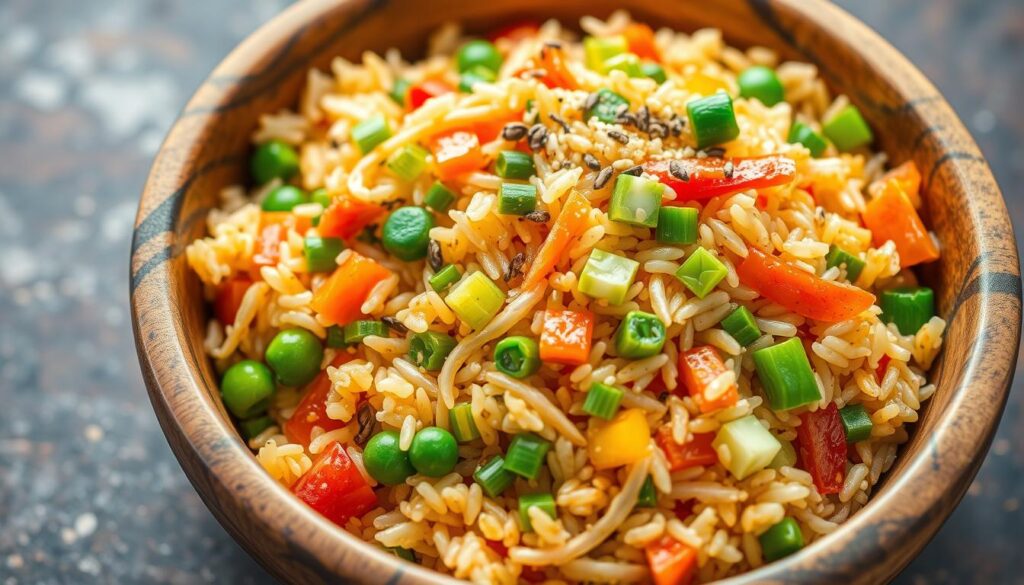
Preparing Your Ingredients
Getting your ingredients ready for your hibachi fried rice recipe is key to a great taste. This step, called “mise en place,” makes sure everything is ready before cooking. It makes the whole process smoother and more fun.
How to Cook the Rice
The base of any fried rice is the rice. Use fresh short-grain or medium-grain white rice for the best taste. Cook it as the package says, but don’t overcook it. Let the rice cool on a baking sheet before adding it to your meal prep fried rice.
Chopping Vegetables Properly
- Dice onions, carrots, and other veggies into small, even pieces. This helps them cook evenly and adds texture to your dish.
- Minced garlic and ginger will make your hibachi fried rice recipe taste amazing.
- Slice green onions at an angle for a nice look in your dish.
Marinating Proteins
Marinate proteins like chicken, shrimp, or beef before adding them to your hibachi fried rice recipe. This makes the proteins tender and flavorful. Mix them with soy sauce, rice vinegar, and sesame oil. Let them marinate for at least 30 minutes before cooking.
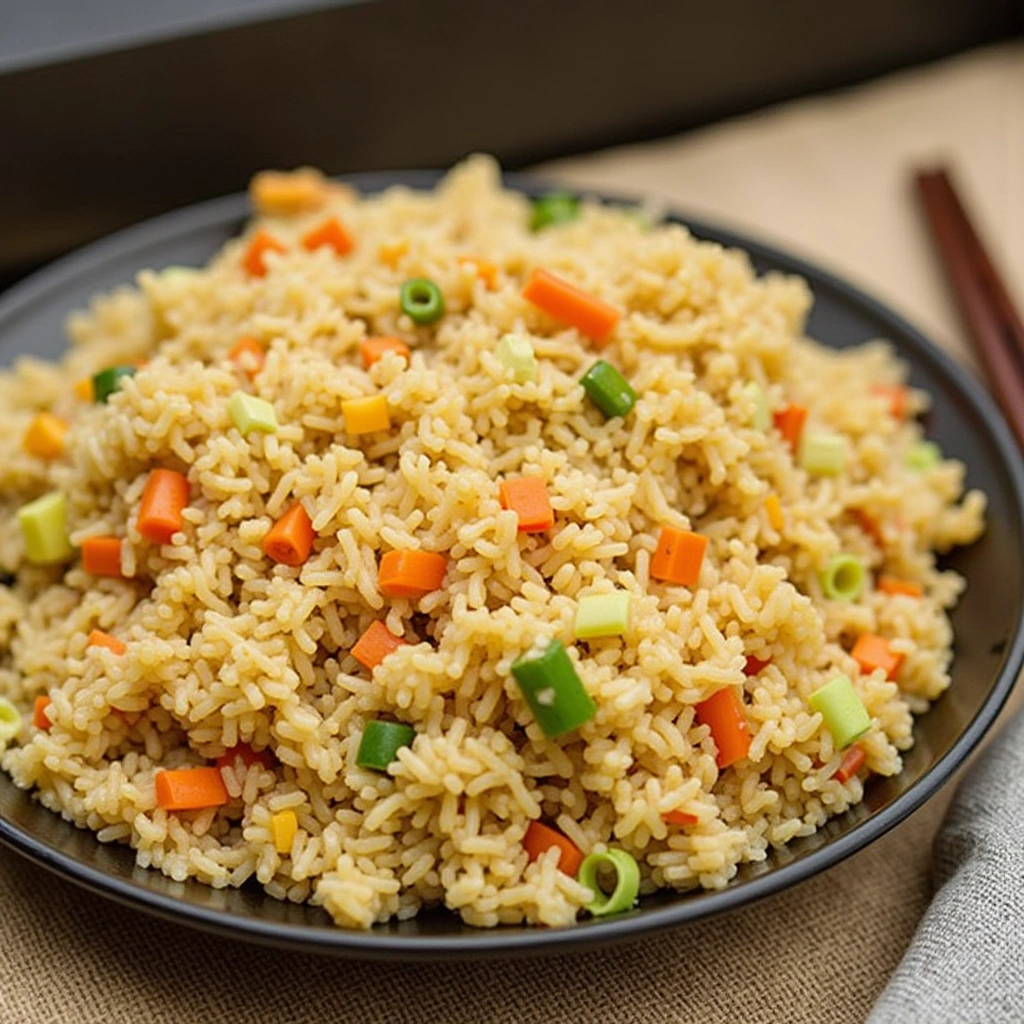
Step-by-Step Guide to Making Hibachi Fried Rice
Making a hibachi fried rice at home is simpler than you think. Just follow this guide to make a tasty easy fried rice dish. It will taste just like the hibachi fried rice recipe from your favorite Japanese steakhouse.
Step 1: Sautéing the Vegetables
First, heat a large wok or skillet over high heat. Add a tablespoon of oil and sauté chopped veggies like carrots, bell peppers, and onions. Cook until they’re tender and slightly charred. This step adds the savory, smoky flavors that make hibachi fried rice authentic.
Step 2: Cooking the Proteins
If you’re adding proteins like chicken, shrimp, or tofu, add them to the skillet. Cook until they’re fully cooked. Season the proteins with soy sauce, garlic, and ginger to boost the flavor.
Step 3: Combining Ingredients
After cooking the veggies and proteins, add the cooked rice to the skillet. Gently toss everything together to mix the flavors. Use high heat to get the right hibachi fried rice texture. Crack a couple of eggs into the skillet and stir them in for a creamy dish.
By following these steps, you can make a restaurant-quality hibachi fried rice at home. Enjoy your homemade hibachi fried rice recipe with your favorite toppings and sides for a complete meal.
Tips for Achieving Restaurant-Quality Flavor
To make your homemade fried rice taste like it’s from a hibachi grill, follow a few key steps. The trick is to use the right seasonings and cook at high heat.
Using the Right Seasonings
Authentic Asian cuisine is all about balance. To get the taste of hibachi-style fried rice right, use these essential seasonings:
- Soy sauce: This umami-rich condiment adds depth and complexity to your dish.
- Garlic butter: A savory, aromatic blend that infuses your rice with mouthwatering flavor.
- Rice vinegar: A splash of this tangy ingredient helps to brighten and balance the overall taste.
- Sesame oil: Just a drizzle of this nutty oil can elevate your fried rice to new heights.
The Importance of High Heat
High-heat cooking is key to hibachi grill recipes. It gives a signature char and caramelized flavor. To get this in your kitchen, turn your stove to the highest heat.
This high heat quickly sears vegetables and proteins. It locks in their flavors, giving you that wok-fried taste.
Mastering seasoning and high-heat cooking will get you close to that restaurant-quality flavor. It’s what makes hibachi fried rice so delicious.
Common Mistakes to Avoid
Making a tasty hibachi fried rice recipe is like an art. Even experienced cooks can slip up. Knowing these common mistakes helps make sure your easy fried rice is always perfect.
Overcooking the Rice
The rice’s texture is key in a good hibachi fried rice. If it’s overcooked, it becomes mushy and clumpy. To prevent this, follow the rice package’s cooking instructions. Don’t let it cook for too long.
Underseasoning
Flavorless fried rice is a disappointment. Seasoning well is crucial for that hibachi taste. Use plenty of soy sauce, sesame oil, and other seasonings. Keep tasting and adjusting until the flavors are just right.
| Common Mistake | Solution |
|---|---|
| Overcooking the rice | Follow package instructions and avoid overcooking |
| Underseasoning | Use generous amounts of soy sauce, sesame oil, and other seasonings |
By avoiding these mistakes and making the right changes, you’ll make a restaurant-quality hibachi fried rice at home.
Customize Your Hibachi Fried Rice
Hibachi fried rice is incredibly versatile. The classic recipe is tasty, but feel free to add your own twist. By using unique ingredients, you can make fried rice that suits your taste and wows your guests.
Adding Unique Ingredients
Customizing hibachi fried rice is easy. Try adding diced pineapple for sweetness, sliced water chestnuts for crunch, or cooked shrimp for a seafood flavor. Herbs like cilantro, basil, or chives can also add a fresh touch. The options are endless, making this dish perfect for personalizing.
Vegetarian and Vegan Variations
For a plant-based diet, hibachi fried rice can be made vegetarian or vegan. Use mushrooms, bell peppers, broccoli, or tofu instead of meat. Add grilled or roasted veggies like asparagus or eggplant for flavor and looks. Season with soy sauce, sesame oil, and sesame seeds for a tasty Asian meal.
Remember, the fun in hibachi fried rice is in experimenting. By trying new ingredients, you can make a dish that’s uniquely yours. It’s a great way to express your culinary creativity.
Serving Suggestions for Hibachi Fried Rice
When you serve your homemade hibachi fried rice, you can make it feel like a real Asian cuisine meal. Try adding side dishes and sauces to make it taste like a Japanese steakhouse. Here are some ideas to make your hibachi grill recipes even better.
Best Side Dishes to Pair
For a full Japanese rice dish experience, pair your hibachi fried rice with these sides:
- Miso soup
- Seaweed salad
- Steamed or sautéed vegetables
- Grilled or teriyaki-glazed proteins, such as chicken, shrimp, or steak
- Fresh sliced cucumbers or carrots with a tangy dipping sauce
Ideal Sauce Recommendations
Every hibachi meal needs the right sauces. Here are some tasty options for your hibachi fried rice:
- Teriyaki sauce: Sweet and savory, it’s perfect with the rice.
- Yum Yum sauce: A creamy, tangy sauce from Japanese steakhouses.
- Spicy mayo: Mayo mixed with sriracha or hot sauce for a kick.
- Ginger-garlic sauce: Enhances the Asian flavors.
With these sides and sauces, your homemade hibachi fried rice becomes a full Asian cuisine meal. Enjoy it in your own kitchen.
Storing and Reheating Leftover Hibachi Fried Rice
Mastering meal prep means using leftovers wisely. Hibachi fried rice is a great example. With a few tips, you can keep your leftovers fresh and tasty all week.
How to Store Properly
Proper storage is key for leftover hibachi fried rice. Cool the rice completely before putting it in an airtight container. This prevents it from getting soggy. Store it in the fridge for up to 4 days for the best taste.
Tips for Reheating
- Don’t reheat fried rice in the microwave. It can dry out the rice.
- Use the stovetop instead. Heat some oil or butter in a skillet over medium. Add the rice and stir-fry until it’s hot and crispy.
- For extra flavor, add soy sauce or garlic powder while reheating.
Follow these tips to enjoy your leftover fried rice all week. Meal prep makes it easy to have delicious hibachi fried rice at home.
Final Thoughts on Making Hibachi Fried Rice
Making hibachi fried rice is a fun journey with many options. It’s all about being creative and making it your own. You can add your favorite ingredients and flavors.
Embracing Your Creativity in the Kitchen
Mastering hibachi fried rice means being open to new ideas. Try different ingredients and flavors. It’s exciting to explore Asian cuisine and see what works for you.
Sharing Your Hibachi Fried Rice Experience
When you get good at making hibachi fried rice, share it with others. Show your friends and family what you’ve made. It’s a great way to connect with others who love food.

